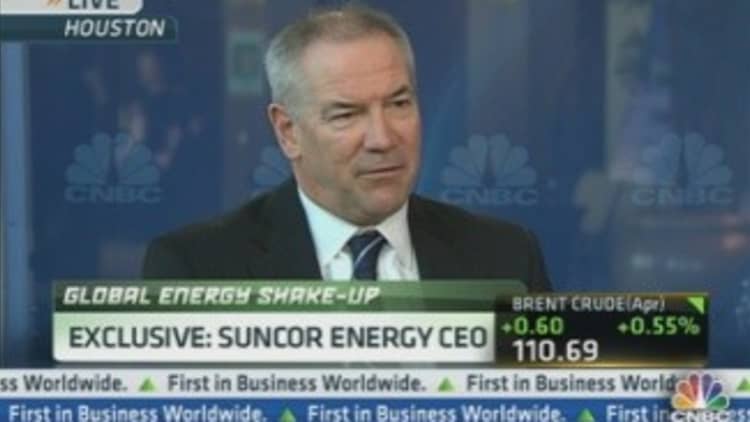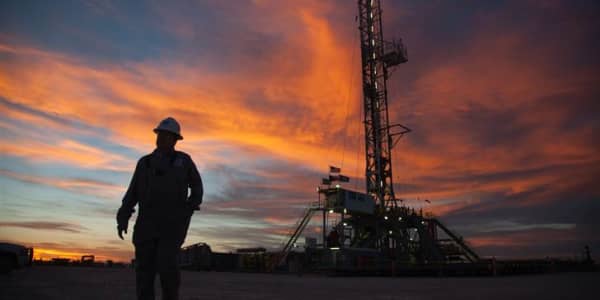
When the Dow last set a record high in late 2007, the U.S. was worried about waning oil supplies and was producing about 40 percent less oil than it produces now.
But a technological breakthrough—the joining of hydraulic fracturing technology and horizontal drilling—has led to an energy revival in the U.S. with now both oil and gas more plentiful than would ever have been expected five years ago.
Representatives of some of those companies that pioneered the new drilling of American oil participated in the IHS CERAWeek energy conference in Houston this week, and on Tuesday several discussed the industry to a standing-room-only crowd.
Jack Stark, senior vice president of exploration with Continental Resources, explained how the Bakken formation in North Dakota has revealed increasingly more oil supply. The company, which went public in 2007, found that by 2012 there was far more there than originally thought, in part because of newer findings in the Three Forks area.
(Read More: Bounty of Natural Gas From Barnett: Survey)
"When we first went into the Bakken, Three Forks wasn't even on my radar," he said. Of the U.S. tight oil drilling plays, the Bakken is the largest, spanning 14,700 square miles and collectively holding 24 billion barrels of potentially recoverable oil equivalent, according to Continental.
Statoil, the Norwegian oil company, saw the Bakken as a land of opportunity in nonconventional drilling. William Maloney, Statoil's executive vice president of development and production for North America, said the U.S. industry benefits from the fact that private landowners hold the mineral rights, unlike other parts of the world. He said the U.S. also has infrastructure in place and technology. The industry has also tackled logistical issues by turning to rail shipping where it lacked pipelines.
All this new crude has resulted in less imported oil into the U.S. Imports totaled about 7.7 million barrels per day in the month of February, down 1.2 million barrels from the same time last year.
The world's largest oil producing company, Saudi Aramco, was also present at CERAWeek, and Khalid Al-Falih, president and CEO, was a keynote speaker before hundreds of attendees. He said when he was a student at Texas A&M in the 1970s, the industry was "feeling great" and the "sky was the limit," much like now.
(Read More: The Drivers of Change: CERAWeek Kicks Off)
He said the industry's exaggerated concern about scarcity has been proven wrong, and at the same time oil demand has moderated due to energy efficiency and slower growth.
The expansion of oil production has also given Saudi Aramco more flexibility in planning. Saudi Aramco has 2.5 million barrels of spare capacity and plans to maintain it.
Saudi Aramco is seeking to develop unconventional gas, has been exploring in the Red Sea and has been investing in solar. Al-Falih said Saudi Aramco is also committed to the U.S. market and its Motiva refining joint venture with Shell Oil on the Gulf Coast.
"Our commitment to this market is unwavering," he said.
Saudi Aramco plans to double refining capacity in the next few years, as well as play a larger role in petrochemicals
Al-Falih also warned to be prepared for cyberattacks. Saudi Aramco was the victim of an attack last year, but there was no loss of oil production or deliveries. Had the hit been successful, it could have had consequences for the oil industry and world economy. "Don't underestimate the bad guys," he said.
The U.S. oil production boom had been expected, but the magnitude of change in such a short period of time is a surprise. Production is at its highest level in 20 years, while at the same time U.S. oil demand is at a 17-year low.
(Read More: Tumbling Oil Prices May Have Further to Fall)
For some perspective, West Texas Intermediate was trading at $80.26 on Dec. 9, 2007, when the Dow closed at 14,164, its closing high, and on Tuesday it was trading at about $90. Even with the boom, the stocks in the S&P energy sector have not even regained where they were before the market bottom in 2009. It is only up 85 percent from the bottom, compared to the leading industry—consumer discretionary, which has more than doubled.
The U.S. is expected to produce 7.3 million barrels per day this year, up from 6.4 million in 2012, according to the Energy Information Administration The International Energy Agency expects the U.S. to surpass Saudi Arabia and Russia by the end of the decade.
But the U.S. industry is not without challenges. Environmentalists and others are concerned about the impact of "fracking," which uses water and sand to drill through rock, on water supplies.
The Keystone XL Pipeline, under review by the Obama administration, was delayed because of environmental concerns and its critics are concerned about the oil sands in Canada. The pipeline would be used to ship oil from Canada to the Gulf Coast.
Suncor CEO Steve Williams also spoke about the importance to the U.S. and Canada of the oil sands supply, saying there has been too much focus on the wrong issues. Suncor is a major sands producer.
"If you shut down the whole of the oil sands, it would shut down one-tenth of one percent of global CO2," he said.
He said the partnership with the U.S. benefits Canadians and Americans, with each dollar the U.S. spends on Canadian oil, 90 cents returns.
Williams said the industry is working to improve technology and environmental issues. For instance, Suncor was able to reduce its fresh-water intake by 30 percent to the lowest level since 1998, even while tripling production.





